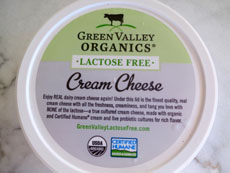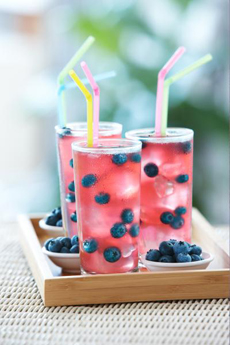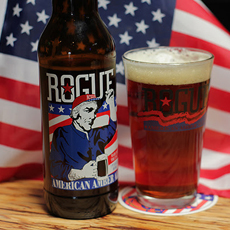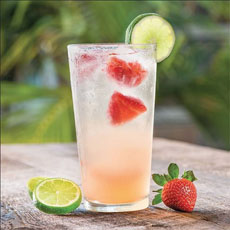
[1] Mixed berry compote atop ice cream (photo © Good Eggs).
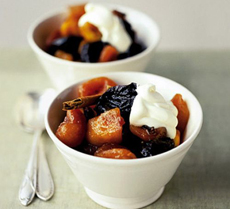
[2] Compote as the main event, topped with mascarpone (photo © Recipes101.com).

[3] A modern variation of the fancy stemmed compote dishes of centuries past (photo © Williams-Sonoma).

[4] Blueberry compote and brie on crostini (photo © CFAA).
|
|
With summer fruits proliferating, here’s an alternative to berry, cherry or peach pie: compote. It’s like eating homemade pie filling—hold the crust.
You can also use it as pancake or oatmeal topping; with plain yogurt, cottage cheese or ricotta; as a toast spread, on cheesecake or angel cake, and so on.
WHAT’S A COMPOTE?
Compote is a cooked fruit dish that was very popular in medieval European.
People of means served it from special stemmed compote dishes.
A compote is a mix of fruits cooked in a syrup. In fact, the name derives from the Latin compositus, mixture. It is also referred to as poached or stewed fruit.
Compote denotes a mixed fruit recipe, but if you have a bumper crop of one particular fruit, you can bend the rules. One of our favorite combinations is blueberries with peaches and/or nectarines and cherries.
Compote faded out of style in the mid-20th century. Bur with an emphasis on two-to-four* fruit servings per day, it’s time to bring it back.
Compote also makes a chunky, chilled summer soup.
It’s like eating homemade pie filling, warm or chilled. With ripe fruit, you can easily cut back on the sugar. We make ours with no sugar at all.
RECIPE #1: SUMMER FRUIT COMPOTE
This recipe takes just 20 minutes on the stove top and is equally delicious warm or chilled. Enjoy it plain or garnished with:
Cream: heavy cream, ice cream, whipped cream
Cheese: mascarpone or ricotta or cannoli cream (recipe below)
A fresh strawberry or stemmed cherry
Dried fruit: apple or other fruit chip, whole apricot or prune
A wafer cookieor gaufrette
Ingredients For 4 Cups
4 pints fruit, washed and patted dry, non-berry fruit cut into bite-size pieces
¼ to ½ cup sugar to taste (less is better and lets the fruit flavor shine through)
1 lemon or small orange, zested
½ cup water
Optional: 1/4 teaspoon spice—allspice, cardamom, cinnamon, ginger or a combination
Optional: 1/4 to 1/2 cup pecan or walnut halves
Garnish of choice
Preparation
1. COMBINE the fruit, sugar, zest, water and optional nuts and spices in a saucepan. Cook over medium heat for 20 minutes, stirring occasionally. The fruit should be soft but not mushy.
2. COOL slightly and serve, or refrigerate. Compote will keep in the fridge for a week, in a sealed container.
3. TO SERVE: Beyond a conventional dessert bowl, you can show off your compote in a glass dish, a goblet, or a pretty porcelain tea cup. In earlier times, special compote dishes were used.
Variation: Add a tablespoon or two or orange juice along with the water.
|
RECIPE #2: CANNOLI CREAM AS A TOPPING
You can slightly sweeten plain ricotta to garnish a compote (spice optional), or can make a smooth cannoli cream with more layers of flavor. This recipe has been modified to use it as a dessert topping instead of a conventional cannoli filling.
Ingredients For 2 Cups
2 cups ricotta cheese
3/4 cup powdered sugar, sifted
1 teaspoon ground cinnamon
1/4 teaspoon allspice
1/4 cup heavy cream
1 lemon or small orange, zested
Preparation
1. WHISK the ricotta until smooth in a medium bowl. Add the powdered sugar, cinnamon and allspice and mix to thoroughly combine.
2. BEAT the heavy cream in a separate bowl until almost stiff. Gently fold it into the ricotta mixture, using a rubber spatula. Refrigerate for at least 30 minutes.
3. STIR in the lemon zest, or sprinkle it on the top of the compote.
________________
*USDA guidelines recommend two servings of fruit per day for adults. The American Heart Association recommends four to five servings of fruit per day.
|

